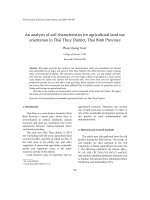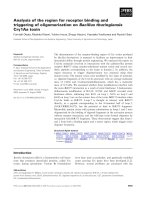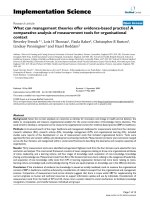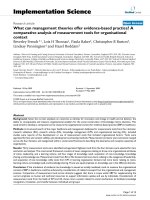Analysis of column interconnects for wafer level packages
Bạn đang xem bản rút gọn của tài liệu. Xem và tải ngay bản đầy đủ của tài liệu tại đây (2.62 MB, 125 trang )
ANALYSIS OF COLUMN INTERCONNECTS FOR
WAFER LEVEL PACKAGES
SUN Wei
(B. Eng, Zhejiang University)
A THESIS SUBMITTED
FOR THE DEGREE OF MASTER OF ENGINEERING
DEPARTMENT OF MECHANICAL ENGINEERING
NATIONAL UNIVERSITY OF SINGAPORE
2005
Acknowledgements
Acknowledgements
Firstly, I’d like to take this opportunity to express my deepest appreciation to my
supervisors, Professor Andrew Tay and Dr. Srikanth Vedantam, for their valuable
guidance and advice all the way. Also, I’d like to thank the Nano Wafer Level
Packaging Program and National University of Singapore for the grant of research
scholarship to support my study and research towards a master’s degree.
Secondly, I hope to give my grateful thanks to my various colleagues, including
Audrey, Zhao Bing, Aiping, Guojun, Manyi, Jidong, Srinivasarao, Gu Jie, Deng
Chun and Ebin for their help during my stay in NWLP lab. Special thanks are
given to Audrey for her many stimulating discussions and advice and Jeremy for
his help with Surface Evolver simulation.
Lastly but not least, I’d like to thank my parents, grandparents and uncle, for their
support and kind understanding, without which I would not be able to finish my
study and research in Singapore.
i
Table of Contents
Table of Contents
Acknowledgements ..................................................................................................i
Table of Contents ....................................................................................................ii
Summary.................................................................................................................vi
List of Figures.........................................................................................................ix
List of Tables ........................................................................................................xiii
CHAPTER 1: Introduction.................................................................................... 1
1.1 Background..................................................................................................... 1
1.2 Program Motivation........................................................................................ 3
1.3 Motivation and Scope of This Work............................................................... 6
1.4 Organization of This Thesis............................................................................ 8
CHAPTER 2: Brief Literature Survey on Fatigue Models................................. 9
2.1 Introduction..................................................................................................... 9
2.2 Strain-Based Fatigue Models........................................................................ 11
2.2.1 Models Based on Plastic Strain...................................................... 11
Coffin-Manson Type....................................................................... 11
Modified Coffin-Manson Type....................................................... 14
2.2.2 Models Based on Creep Strain....................................................... 16
2.2.3 Combination of Plastic and Creep Strain....................................... 17
Miner’s Rule ................................................................................... 17
Strain Range Partitioning................................................................ 17
ii
Table of Contents
2.3 Energy-Based Fatigue Models...................................................................... 18
2.3.1 Non Crack-Propagation-Included Models ..................................... 18
Energy Partitioning ......................................................................... 18
Models Based on Total Energy....................................................... 19
2.3.2 Models Which Include Crack-Propagation.................................... 20
2.4 Conclusion .................................................................................................... 21
CHAPTER 3: Simulation-based Design Optimization on CuC ....................... 24
3.1 Introduction................................................................................................... 24
3.2 Steps of Simulation-based Design Optimization .......................................... 27
3.2.1 Problem Definition......................................................................... 27
3.2.2 Identification of Design Factors, Space and Constraints ............... 27
3.2.3 DoE Setup ...................................................................................... 28
3.2.4 Finite Element Analysis................................................................. 30
3.2.5 Responses Extraction ..................................................................... 30
3.2.6 Surrogate Model Construction....................................................... 30
3.2.7 Optimization .................................................................................. 32
3.2.8 Conclusion ..................................................................................... 32
3.3 Optimization Study on the CuC Interconnect............................................... 33
3.3.1 A Brief Note on the CuC Interconnect .......................................... 33
3.3.2 Problem Definition......................................................................... 34
3.3.3 Identification of Design Factors and Space ................................... 34
iii
Table of Contents
3.3.4 DoE Study Setup............................................................................ 35
3.3.5 Finite Element Analysis................................................................. 37
Geometry and Mesh........................................................................ 37
Loading and Boundary Conditions ................................................. 39
Material Properties.......................................................................... 40
3.3.6 Responses Extraction ..................................................................... 43
3.3.7 Surrogate Model Construction....................................................... 46
3.4 Summary and Conclusion............................................................................. 55
CHAPTER 4: Fatigue Life Estimation of CuC Interconnect ........................... 56
4.1 Finite Element Modeling .............................................................................. 56
4.1.1 Introduction.................................................................................... 56
4.1.2 Difficulty in FEA ........................................................................... 56
4.1.3 Shell-and-Beam Model .................................................................. 58
4.1.4 Shell-to-Solid Submodeling and Coupling .................................... 62
4.2 Feasibility Analysis....................................................................................... 63
4.2.1 Modeling Methodologies ............................................................... 63
4.2.2 The Dummy Package..................................................................... 65
Full 3D Model................................................................................. 65
Shell-and-Beam-Submodeling........................................................ 66
Shell-and-Beam-Coupling .............................................................. 68
Results and Discussion ................................................................... 69
iv
Table of Contents
4.2.3 Summary and Conclusion .............................................................. 80
4.3 Fatigue Life Estimation of CuC Interconnect............................................... 82
4.3.1 The CuC Interconnect and Package under Investigation............... 82
4.3.2 Solder Joint Shape Prediction ........................................................ 84
4.3.3 Equivalent Beam Representation................................................... 87
4.3.4 Global shell-and-beam model ........................................................ 92
4.3.5 Shell-to-solid submodeling ............................................................ 94
4.3.6 Discussion ...................................................................................... 98
4.3.7 Conclusions.................................................................................... 98
CHAPTER 5: Conclusions of the Current Thesis ........................................... 100
References............................................................................................................ 103
v
Summary
Summary
Copper column (CuC) interconnect is proposed in the Nano Wafer Level
Packaging (NWLP) program as a candidate chip-to-substrate interconnect solution
and is the focus of investigation in this thesis.
In this thesis, a literature survey on fatigue life correlation models and two
important tasks are completed. The two important tasks are:
First, a simulation-based design optimization process is established based on our
available software resources, ABAQUS and Minitab. This process integrates finite
element analysis (FEA), design of experiment (DoE) technique and numerical
optimization, generating a systematic and efficient method that can be used to
study the effects of various design parameters on desired system response. The
significance of this simulation-based design optimization process lies in its general
applicability in various design scenarios where effect of each design parameter on
the system response is of interest, investigation of interaction of design parameters
is needed and an optimal design parameter setting is required. After the
establishment of this optimization process, a case study on CuC interconnect in
wafer level packages is detailed. It is found that the substrate coefficient of thermal
expansion (CTE) has the largest influence on solder joint fatigue reliability. The
chip thickness has the second largest influence with a smaller chip thickness
leading to better solder joint reliability. The substrate thickness plays the third
vi
Summary
most important role with a thinner substrate thickness giving longer fatigue life. It
is also found that increasing CuC height will result in better solder joint fatigue
performance. Finally we find that the optimal design combination is: low-level
substrate CTE, chip and substrate thickness, and high-level CuC height.
Secondly, two new and novel advanced finite element simulation methodologies,
based on simplifying chip/substrate as shells and interconnects as beams, are
developed to address the difficulty of modeling the large number of CuC
interconnects in a 20mm by 20mm wafer level package with ultra-fine pitch.
Although the idea of using shell and beam elements to model substrate/chip and
interconnects is not new, previous researchers have not accurately translated the
displacement results from the global shell-and-beam-based model to the local
model. This thesis describes first-ever the application of the shell-to-solid
submodeling and shell-to-solid coupling techniques available in ABAQUS to
overcome the above-mentioned difficulty in the context of modeling solder joint
fatigue of electronic packages. A feasibility demonstration of the two
methodologies is firstly carried out. A great saving of computational resources is
realized and results show that good accuracy is achieved. After this, as a case study,
the shell-and-beam-submodeling approach is chosen for fatigue life prediction of
three different CuC interconnects in 20mm by 20mm wafer level packages with
100µm pitch. By using the shell-to-solid submodeling technique, the stress/strain
of the critical solder joint can be derived. Fatigue life prediction can then be
vii
Summary
performed based on Solomon’s fatigue correlation. It should be noted that the
shell-and-beam-submodeling approach can be used not only in the thermomechanical but also in drop impact simulation of electronic packages.
viii
List of Figures
List of Figures
Figure 1.1 Conventional packaging in comparison with WLP [2] ........................... 2
Figure 1.2 Proposed 100µm pitch interconnects ...................................................... 5
Figure 3.1 Typical flow chart for Simulation-based Design Optimization ............ 27
Figure 3.2 Schematic picture of the CuC interconnect ........................................... 33
Figure 3.3 Illustrations of Design Factors............................................................... 34
Figure 3.4 Dimensions of the CuC interconnect..................................................... 38
Figure 3.5 2D mesh of the electronic package under investigation (a close-up view
of the corner part).................................................................................................... 38
Figure 3.6 Temperature cycling profile .................................................................. 40
Figure 3.7 Boundary conditions of the 2D finite element model ........................... 40
Figure 3.8 Predicted values VS simulation results ................................................. 47
Figure 3.9 Normal probability plot of factor effects............................................... 48
Figure 3.10 Influences of design factors and interactions on ∆ε avg value .............. 51
Figure 3.11(a) Response surface plot of ∆ε avg vs. chip thickness and substrate
thickness.................................................................................................................. 52
Figure 3.11(b) Response surface plot of ∆ε avg vs. chip thickness and CuC height 52
ix
List of Figures
Figure 3.11(c) Response surface plot of ∆ε avg vs. chip thickness and substrate CTE
................................................................................................................................. 53
Figure 3.11(d) Response surface plot of ∆ε avg vs. substrate thickness and CuC
height....................................................................................................................... 53
Figure 3.11(e) Response surface plot of ∆ε avg vs. substrate CTE and substrate
thickness.................................................................................................................. 54
Figure 3.11(f) Response surface plot of ∆ε avg vs. CuC height and substrate CTE. 54
Figure 4.1 Schematic picture of the reference plane of the shell elements............. 61
Figure 4.2 Shell-to-solid submodeling [65] ............................................................ 63
Figure 4.3 Shell-to-solid coupling [65]................................................................... 63
Figure 4.4 Finite element mesh of the dummy package ......................................... 66
Figure 4.5 Finite element mesh of the global shell-and-beam model..................... 67
Figure 4.6 Finite element mesh of the submodel of the critical interconnect......... 68
Figure 4.7 Finite element mesh of the shell-and-beam-coupling model ................ 69
Figure 4.8 Displacement (Z-direction) contour of the chip in full 3D model......... 73
Figure 4.9 Displacement (Z-direction) contour of the chip in global shell-and-beam
model....................................................................................................................... 73
Figure 4.10 Displacement (Z-direction) contour of the chip in shell-to-solidcoupling model........................................................................................................ 74
x
List of Figures
Figure 4.11 Comparison of deformed shape of the 4mm by 4mm package after
temperature drop from 125 oC to -40 oC. (a) Top of interconnect, and (b) bottom of
interconnect............................................................................................................. 75
Figure 4.12 Time history deformation of the global shell-and-beam model and full
3D model................................................................................................................. 76
Figure 4.13 Stress contour plot for the corner CuC interconnect in the full 3D
model....................................................................................................................... 77
Figure 4.14 Stress contour plot for the corner CuC interconnect using the shell-tosolid-submodeling approach ................................................................................... 77
Figure 4.15 Stress contour plot for the corner CuC interconnect using the shell-tosolid-coupling approach.......................................................................................... 78
Figure 4.16 Stress contour plot for the corner CuC interconnect using the original
Chng’s micro modeling approach (Chng, 2003)..................................................... 78
Figure 4.17 Schematic picture of the CuC interconnect ......................................... 83
Figure 4.18 Dimensions of CuC interconnect......................................................... 83
Figure 4.19 Predicted solder joint shape by Surface Evolver................................. 86
Figure 4.20 Micro model of CuC interconnect....................................................... 90
Figure 4.21 Force-displacement characteristics of micro model ............................ 91
Figure 4.22 Comparison of X-displacement of equivalent beam ........................... 92
Figure 4.23 Comparison of Z-displacement of equivalent beam............................ 92
Figure 4.24 Global shell-and-beam model and local zoom-in view....................... 93
xi
List of Figures
Figure 4.25 Deformation of global model at -40oC (first cycle)............................ 94
Figure 4.26 Submodel of critical CuC interconnect ............................................... 95
Figure 4.27 Failure site identified using the modified macro-micro modeling
approach.................................................................................................................. 97
Figure 4.28 Failure sites identified using the original macro-micro modeling
approach.................................................................................................................. 97
xii
List of Tables
List of Tables
Table 1.1 Main design parameters of the proposed interconnects............................ 5
Table 2.1 Category of fatigue [6]............................................................................ 10
Table 3.1 Design factors and their variations ......................................................... 35
Table 3.2 DoE design table..................................................................................... 36
Table 3.3 Details of modeling parameters .............................................................. 37
Table 3.4 Material properties for chip and FR4 board............................................ 41
Table 3.5 Material properties for copper ................................................................ 42
Table 3.6 Material properties for solder ................................................................. 43
Table 3.7 Reponses of all the sixteen finite element models.................................. 45
Table 3.8 List of unscaled and scaled coefficients ................................................. 50
Table 4.1 Geometrical parameters of the dummy package..................................... 66
Table 4.2 Displacement result comparison between the three models ................... 74
Table 4.3 Mises stress result comparison between the four models ....................... 79
Table 4.4 Requirements of various models in analyzing a 4mm by 4mm dummy
package ................................................................................................................... 79
Table 4.5 Details of modeling parameters .............................................................. 84
Table 4.6 Parameters used for solder shape prediction by Surface Evolver........... 87
Table 4.7 Equivalent beams (EBs) for CuC interconnects ..................................... 88
Table 4.8 Fatigue lives of the three CuC interconnects .......................................... 96
xiii
Chapter 1: Introduction
CHAPTER 1: Introduction
1.1 Background
Since the emergence of Large Scale Integrated-circuit (LSI), the electronic
packaging industry has gone through two revolutions [1]. The transition from Pin
through Hole (PTH) technology to Surface Mount Technology (SMT) stands for
the first revolution. After this revolution Quad Flat Package (QFP) became widely
used by the industry to replace the traditional Dual in-line Package (DIP) for
denser assembly on Printed Circuit Board (PCB).
The second revolution is typified by the invention of the Ball Grid Array (BGA).
The emergence of BGA was driven by the need for integration of larger number of
I/Os in the package and relatively coarser interconnect pitch. BGA meets the need
for higher I/O number because it adopts an area array interconnect methodology
instead of the peripheral array methodology used by QFP. Therefore, with the
same I/O number BGA can realize a coarser pitch than QFP, making assembly of
BGA much easier.
Currently electronic packaging industry is going through the third revolution. The
need for high speed, high power, high number of I/Os, low cost and high
performance IC packages calls for new advances in packaging technology. Among
all the advances, Wafer Level Packaging (WLP) is the most promising one. In
WLP, the package interconnects are fabricated directly on the wafers, the test and
1
Chapter 1: Introduction
burn-in process are done at the wafer level, and the dies after dicing are directly
ready for SMT assembly [2]. A typical WLP process flow is shown is Figure 1.1.
Wafer Fab & Probe
AND
Additional Processing
(Optional)
Conventional Process
Dicing into ICs
New Wafer-level Process
Wafer-level Burn-in
& Test
Individual IC
Assembly into
Ship to Customer
Package
Burn-in & Test Each
Package
Ship to Customer
Figure 1.1 Conventional packaging in comparison with WLP [2]
As a result of the new process flow, WLP is expected to provide the following
advantages [2]:
•
Providing the smallest system size, because it is truly a chip size
package
•
Enabling interconnect continuum from IC to PCB because of thin film
processing
2
Chapter 1: Introduction
•
Reduced cost of packaging, because all the interconnects are fabricated
at the wafer level
•
Reduced cost of testing, because testing is done at the wafer level for all
ICs
•
Reduced cost of burn-in, because the burn-in is done at the wafer level
once
•
Elimination of underfill because of compliancy of the leads or other
ways to achieve reliability
•
Improved electrical performance because of short lead lengths
The two most important momentums driving WLP are size benefits for portable
products and cost benefits for all products [2].
1.2 Program Motivation
The International Technology Roadmap for Semiconductors (ITRS) 2003 indicated
that the IC feature size is expected to go down to 32 nm and the pitch to 20µm in
the year 2013 [3]. Accordingly, in 2002, the NWLP program, an international
collaboration among the National University of Singapore, Institute of
Microelectronics, and the Packaging Research Center at Georgia Institute of
Technology, USA, was initiated with the vision to develop nano-structured
interconnect solutions for ultra-fine pitch WLP. The ultimate purpose of this
collaboration is to develop interconnect solutions for high speed, high power IC
3
Chapter 1: Introduction
packages with pitch size of 100µm and explore possible solutions for 20µm pitch
using nano-structured materials [4] [5].
NWLP is actually an advanced version of the WLP because it extends the current
WLP technology to ultra-fine interconnect pitch and explore the use of nanostructured materials to WLP for state-of-the-art package performance.
At the initial phase of this program our research focus is, however, to develop
interconnect solutions for the next generation WLP with 100µm pitch [4].
Four candidate solutions that extend the current state of the interconnect
technology are proposed. They are [5]:
•
Solder Ball with No-flow Underfill (SB)
•
Bed of Nails (BON)
•
Stretched Solder Column (SSC)
•
Copper Column Interconnect (CuC)
Figure 1.2 is a schematic picture of the four interconnects and Table 1.1 lists the
main design parameters.
4
Chapter 1: Introduction
Silicon chip
BON
SB
SSC
CuC
High density
board
Figure 1.2 Proposed 100µm pitch interconnects
Table 1.1 Main design parameters of the proposed interconnects
Size of Chip
Pitch of Interconnect
20mm by 20mm
100µm
Number of I/Os
10,000 per cm2
Temperature Cycling Range
-40 oC to 125 oC
Thermal Cycle Fatigue Life
1000 cycles (target)
The SB interconnect is basically an extension of current technology down to
100µm pitch with no-flow underfill. It is a rigid interconnect. The BON
interconnect consists of three segments of electroplated copper in a Z-shaped
structure and is expected to be joined to the substrate using solder. It is a compliant
interconnect. The SSC interconnect is fabricated by stretching molten high-lead
solder bump to an hourglass shape. After that it is joined to the substrate with leadfree or eutectic solder. It is supposed to be a semi-compliant interconnect [4]. The
CuC interconnect is actually a simplified version of the BON interconnect. In this
interconnect technology a copper column with circular cross section is formed by
5
Chapter 1: Introduction
electroplating and joined to the substrate with solder. Therefore, the CuC
interconnect is much easier to process than the BON interconnect. CuC
interconnect is also a compliant interconnect.
CuC interconnect will be the focus of this thesis.
1.3 Motivation and Scope of This Work
As far as long-term reliability of IC packages is concerned, the integrity of solder
joints under cyclic temperature changes, known as thermo-mechanical reliability,
must be guaranteed. This thermo-mechanical reliability concern arises from the
CTE mismatch between silicon chip and substrate. As IC packages experience
cyclic temperature changes, i.e. power on and off, the chip and substrate expand or
shrink differently due to CTE difference. This difference of expansion or shrinkage
make the solder joints between the chip and substrate undergo cyclic load and
eventually cause low cycle fatigue failure.
The solder joint thermo-mechanical reliability is already a major concern for
current electronic packages and is expected to be critical in view of the proposed
chip size of 20mm by 20mm and pitch of 100µm in the NWLP program. Before
any physical prototypes are made and experiments carried out, it is often of interest
to 1) do a design optimization study to find out the effects of various design
parameters on solder joint reliability and find out an optimal set of design
6
Chapter 1: Introduction
parameters combination that leads to maximum solder joint fatigue life; 2) conduct
FEA to estimate the solder joint fatigue life of the critical interconnect.
To do a design optimization analysis of CuC interconnect, a 2D plane strain finite
element model is an adequate and efficient. However, when accurate modeling of
solder joint fatigue is required, the 2D finite element model is not adequate due to
its underlying inaccurate assumption. Full 3D finite element modeling is necessary.
But in light of the large package size and ultra-fine interconnect pitch coupled with
the requirement for full area array, modeling of solder joint fatigue is a challenge
for the current computational resources. Therefore, one of the aims of this thesis is
to develop efficient and accurate modeling method to address the challenge.
To sum up, the objectives of this work are to:
•
Do a design optimization study to find out the effects of changes of
various design parameters on solder joint reliability and determine an
optimal parameter combination.
•
Develop an efficient and accurate modeling method to address the
challenge of modeling solder joint fatigue.
•
Use the developed modeling methodology to estimate the solder joint
fatigue life of the critical corner interconnect of some CuC packages.
7
Chapter 1: Introduction
1.4 Organization of This Thesis
This thesis consists of four chapters. Chapter 1 serves as an introduction which
describes the industry background, the motivation of the NWLP program, and the
motivation and scope of the current work. Chapter 2 is a review of the popular
fatigue models including both strain and energy-based models. Chapter 3 contains
the simulation-based design optimization process establishment procedures and a
case study. Chapter 4 provides the details the newly developed simulation
methodologies that can be used to efficiently address the simulation difficulty of
CuC interconnect in 20mm by 20mm wafer level package with 100µm pitch.
8
Chapter 2: Brief Literature Survey on Fatigue Models
CHAPTER 2: Brief Literature Survey on Fatigue Models
2.1 Introduction
The eutectic Pb-Sn solder is widely used in the electronic packaging industry
because its low melting point allows solder joint to be formed at temperatures low
enough to prevent device failure. As far as long-term reliability is concerned, the
solder joint sustainability under cyclic temperature changes is vital. This is because
during service life the package will experience power on and off as well as ambient
temperature changes, causing the solder joints to experience cyclic loadings and
eventually failures occur. The primary failure mechanism of eutectic Pb-Sn solder
joint under thermal cycling is fatigue. Fatigue occurs when material undergoes
repetitive loading. The repetitive loading causes damage to material. Unlike some
biomaterials, this damage is cumulative and unrecoverable [6]. When this damage
cumulates to a certain level, crack initiates and propagates across the material and
failure occurs. There are two types of fatigue, namely high cycle fatigue and low
cycle fatigue. The definitions and characteristics of these two types of fatigue are
shown in Table 2.1 [6]. According to Table 2.1, solder joint fatigue in electronic
packaging is categorized as low cycle fatigue. This is true because solder joints are
often stressed beyond their yielding point during thermal cycling and the number
of cycles to failure is much lower than 104.
9
Chapter 2: Brief Literature Survey on Fatigue Models
Table 2.1 Category of fatigue [6]
Low cycle fatigue
•
Significant plastic strain in each cycle
•
High load
•
Low number of cycles to failure, from 1 to 104 or
105 cycles
High cycle fatigue
•
Largely confined to elastic range
•
Low load
•
Long life, greater than 104 or 105 cycles
Since solder joints electrically and mechanically connect the chip and substrate,
their integrities are important to ensure the package’s long-term functionality.
Therefore, there is a great interest in evaluating and predicting the solder joint
fatigue life under thermal cycling. A cost-effective way for fatigue life prediction
is to use finite element analysis coupled with fatigue models.
There are many fatigue models derived by different researchers using different
methods. According to the different damage indicators used, the majority of those
models can be categorized as strain-based and energy-based [7] [8]. Other less
popular ones include crack-based, stress-based and entropy-based [9]. In current
literature survey, only two most popular ones which are the strain-based and
energy-based fatigue models will be reviewed. Since only eutectic Pb-Sn solder
will be used in this work, emphasis will be put on eutectic and near-eutectic
solders.
10
Chapter 2: Brief Literature Survey on Fatigue Models
2.2 Strain-Based Fatigue Models
The most widely used fatigue models are strain based. Some of them are based on
plastic strain, some on creep strain, and others on total strain.
2.2.1 Models Based on Plastic Strain
Some of the fatigue models, based on plastic strain only account for plastic strain
(i.e. the fatigue is only related to plastic strain range) and thus is categorized as
Coffin-Manson type fatigue models. Others may also take into account the cyclic
frequency, cyclic temperature range, mean temperature, dwell times, dwell
temperatures and loading rates, and thus categorized as Modified Coffin-Manson
type fatigue models [7] [8].
Coffin-Manson Type
Coffin [10] and Manson [11] reported that the total number of cycles to failure,
N f , is related to plastic strain range, ∆γ p . This relation is expressed in Equation
(2.1).
∆ε p
2
= ε 'f ( 2 N f
)
c
(2.1)
The fatigue ductility coefficient, ε 'f , is approximately equal to the true fracture
ductility, ε f . The fatigue ductility exponent, c , is a material constant that varies
between -0.5 and -0.7 [12]. Either fatigue experiments or FEA modeling can be
adopted to derive the plastic strain range, ∆ε p , for fatigue life prediction. This
Coffin-Manson fatigue model is widely used due to its simplicity. However, the
11









